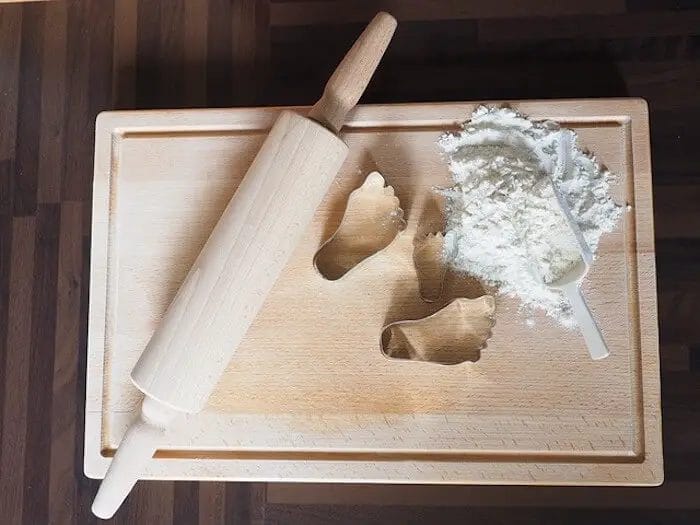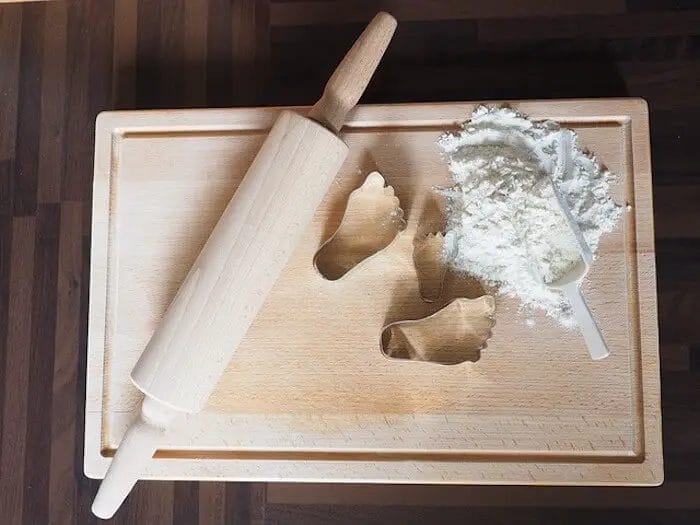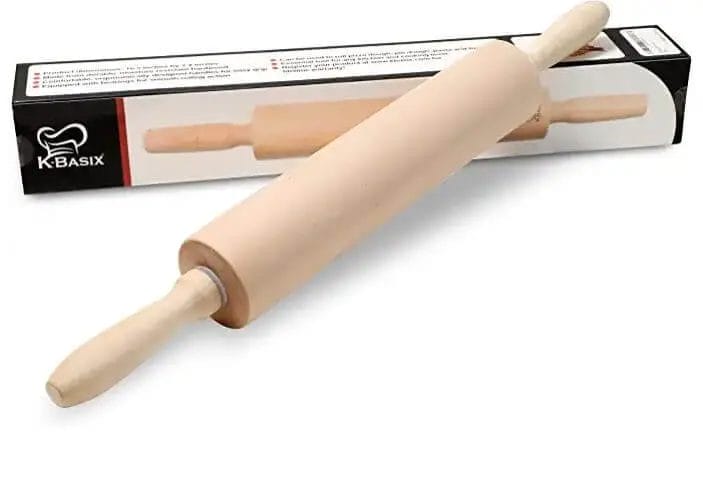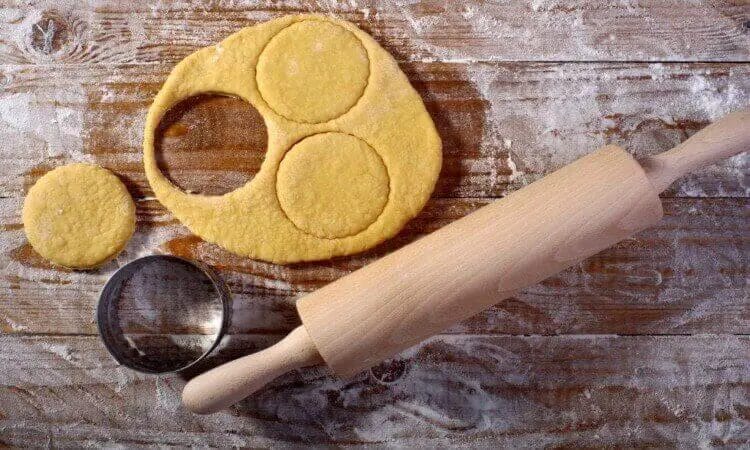Are you wondering how to clean your wooden rolling pin without damaging it? Look no further! Cleaning a wooden rolling pin is a simple and straightforward process that will keep it in pristine condition for years to come.
Start by wiping off any excess flour or dough from the surface of the rolling pin using a dry cloth or brush. Then, dampen a clean cloth or sponge with mild dish soap and warm water. Gently scrub the entire surface of the rolling pin, including the handles, to remove any remaining residue.

Rinse the rolling pin thoroughly with warm water to remove any soap residue. Dry it with a clean towel, making sure to remove all moisture. Avoid letting the rolling pin sit in water or submerging it, as this can cause the wood to warp or crack.
To maintain the quality of your wooden rolling pin, it’s recommended to periodically apply a food-grade mineral oil or beeswax conditioner. This will help prevent the wood from drying out and keep it moisturized.
By following these simple steps, you can keep your wooden rolling pin clean and in excellent condition, ensuring smooth and effortless dough rolling every time!

Using Vinegar to Clean and Sanitize Your Wooden Rolling Pin
Wooden rolling pins are a popular choice for bakers due to their durability and natural aesthetic. However, over time, they can accumulate dirt, grease, and bacteria, which can affect both the taste and hygiene of your baked goods. To keep your wooden rolling pin clean and sanitized, you may be surprised to learn that vinegar can be a highly effective and affordable cleaning agent. In this section, we will discuss the steps and benefits of using vinegar to clean and sanitize your wooden rolling pin.
Materials Needed:
- White vinegar
- Water
- Clean cloth or sponge
- Mild dish soap (optional)
Steps to Clean and Sanitize a Wooden Rolling Pin with Vinegar:
1. Begin by removing any visible debris or residue from your wooden rolling pin. You can use a clean, dry cloth to wipe off any loose particles.
2. In a small container or bowl, mix equal parts white vinegar and water. The acidic properties of vinegar help cut through grease and grime, while also acting as a natural disinfectant.
3. Dip a clean cloth or sponge into the vinegar solution, ensuring it is thoroughly soaked. You can also wrap the cloth around the rolling pin if it is more convenient.
4. Gently scrub the wooden rolling pin with the vinegar-soaked cloth, paying attention to all areas, including the handles and any engravings or patterns. The vinegar will help remove any stubborn stains or odors.
5. For tougher stains or sticky residue, you can add a small amount of mild dish soap to the vinegar solution. This will provide additional cleaning power without damaging the wood.
6. After thoroughly cleaning the wooden rolling pin, rinse it under warm running water to remove any vinegar or soap residue.
7. Once rinsed, use a clean, dry cloth to remove excess moisture from the rolling pin. It is important to dry it thoroughly to prevent any warping or mold growth.
8. Finally, allow the wooden rolling pin to air dry completely before storing it in a clean and dry location.
Benefits of Using Vinegar:
Vinegar offers several benefits when used to clean and sanitize a wooden rolling pin:
- Natural disinfectant: Vinegar has antimicrobial properties that can help eliminate bacteria, mold, and mildew on the surface of your wooden rolling pin.
- Gentle on wood: Unlike harsh chemical cleaners, vinegar is a natural and non-toxic option for cleaning wooden surfaces. It is less likely to cause damage or discoloration to your rolling pin.
- Economical: Vinegar is an affordable cleaning agent that can be found in most households. It offers a cost-effective solution for keeping your wooden rolling pin clean and hygienic.
- Environmentally friendly: Using vinegar reduces the need for chemical-based cleaning products, making it an eco-friendly choice for maintaining your wooden rolling pin.
Note: It is important to note that while vinegar is effective in cleaning and sanitizing wooden rolling pins, it may not be suitable for all types of wood. If you are uncertain, it is recommended to test the vinegar solution on a small, inconspicuous area of the rolling pin before proceeding with a full cleaning.
In summary, vinegar can be a highly effective and affordable solution for cleaning and sanitizing your wooden rolling pin. With its natural disinfectant properties and gentle cleaning action, vinegar can help keep your rolling pin free from bacteria and grime, ensuring that your baked goods are both delicious and hygienic.

Lemon and Salt: A Natural Cleaning Solution for Wooden Rolling Pins
Wooden rolling pins are a staple in many kitchens, but over time, they can accumulate grime and food residue. While there are various cleaning products available on the market, using natural solutions is not only cost-effective but also environmentally friendly. One such natural cleaning solution for wooden rolling pins is the combination of lemon and salt.
Materials Needed:
- 1 lemon
- Salt
- Warm water
- A soft cloth or sponge
Step 1: Cut and Squeeze the Lemon
Start by cutting the lemon in half. Squeeze the juice from one half of the lemon into a small bowl. Lemon juice is a natural cleaning agent due to its acidity, which helps break down stains and remove grime.
Step 2: Sprinkle Salt on the Rolling Pin
Take the other half of the lemon and dip it into the bowl of lemon juice. Rub the lemon half all over the wooden rolling pin, making sure to cover the entire surface. The lemon juice will help loosen any debris or food particles stuck to the rolling pin.
Next, sprinkle a generous amount of salt onto the rolling pin. Salt acts as a gentle abrasive, aiding in the removal of stubborn stains and residue. Make sure to cover the entire rolling pin with the salt.
Step 3: Scrub the Rolling Pin
Using a soft cloth or sponge, gently scrub the rolling pin in circular motions. The combination of lemon juice and salt will create a paste-like consistency, allowing for effective cleaning. Pay extra attention to any areas with visible stains or buildup.
Continue scrubbing until you are satisfied with the cleanliness of the rolling pin. The lemon juice and salt mixture will help break down and lift away any dirt or grime, leaving your wooden rolling pin looking fresh and clean.
Step 4: Rinse and Dry
Once you have finished scrubbing, rinse the rolling pin under warm water to remove any remaining lemon juice and salt. Ensure that all traces of the cleaning mixture are washed away. Pat the rolling pin dry with a clean towel.
It is important to note that wooden rolling pins should not be soaked in water or left to air dry, as this can lead to warping or cracking. Always remember to dry the rolling pin thoroughly after cleaning.
Step 5: Apply a Protective Finish (Optional)
If desired, you can apply a protective finish to your wooden rolling pin to prolong its lifespan and maintain its natural beauty. Food-grade mineral oil or beeswax are common options for sealing and conditioning wooden kitchen utensils.
Simply apply a small amount of the chosen finish onto a clean cloth and rub it onto the rolling pin in the direction of the grain. Allow the finish to penetrate the wood for a few minutes, then wipe off any excess. Follow the manufacturer’s instructions for the specific product you are using.
Summary
Cleaning your wooden rolling pin with a natural solution like lemon and salt is not only effective but also safe for both you and the environment. The acidity of lemon juice helps break down stains, while salt acts as a gentle abrasive to remove grime.
Remember to cut and squeeze a lemon, sprinkle salt on the rolling pin, scrub it with a soft cloth or sponge, rinse it thoroughly, and dry it properly. If desired, you can also apply a protective finish to maintain the rolling pin’s longevity.
By using this natural cleaning solution, you can ensure that your wooden rolling pin remains in pristine condition, ready for all your baking needs.

Cleaning Wooden Rolling Pins with Baking Soda and Water
Wooden rolling pins are a staple in every baker’s kitchen. They are not only functional but also add a rustic touch to your baking endeavors. However, just like any other kitchen tool, wooden rolling pins can become dirty and stained over time. Thankfully, there is a simple and effective way to clean your wooden rolling pins using baking soda and water.
Materials:
- Wooden rolling pin
- Baking soda
- Water
- Soft cloth or sponge
Instructions:
1. Start by preparing a cleaning solution. In a small bowl, mix equal parts baking soda and water to form a paste-like consistency.
2. Dampen a soft cloth or sponge with water and gently wipe down the wooden rolling pin to remove any loose debris or surface dirt.
3. Take a small amount of the baking soda paste and rub it onto the surface of the rolling pin. Use gentle circular motions to distribute the paste evenly. The mild abrasive properties of baking soda will help to lift and remove stains without damaging the wood.
4. Allow the baking soda paste to sit on the rolling pin for about 10-15 minutes. This will give it time to work its magic and break down any stubborn stains.
5. After the designated time, rinse the rolling pin under warm running water. Make sure to remove all traces of the baking soda paste, as any residue left behind could affect the taste of your baked goods.
6. Once rinsed, use a clean cloth or towel to pat the rolling pin dry. Avoid leaving it to air dry, as excess moisture can cause the wood to warp or crack.
7. Finally, allow the rolling pin to fully air dry in a well-ventilated area before storing it away. It’s essential to ensure that it is completely dry to prevent the growth of mold or mildew.
Tips:
- Avoid submerging the wooden rolling pin in water or soaking it for extended periods. Excessive moisture can damage the wood.
- For tougher stains or grime, you can add a few drops of lemon juice or vinegar to the baking soda paste. These natural ingredients have additional cleaning properties.
- Regularly oiling your wooden rolling pin with food-grade mineral oil can help maintain its condition and prevent it from drying out.
In summary, cleaning your wooden rolling pin with baking soda and water is a simple and effective method. By following these steps and taking proper care of your rolling pin, you can keep it in top-notch condition for all your baking adventures.
5. The Importance of Properly Drying and Storing Your Wooden Rolling Pin
When it comes to baking, a wooden rolling pin is a timeless and essential tool in any kitchen. Whether you are making pie crusts, cookies, or bread, a well-maintained rolling pin can make a significant difference in achieving the perfect dough consistency and texture. However, it is essential to handle and care for your wooden rolling pin properly to ensure its longevity and optimal performance.
1. Drying Your Wooden Rolling Pin:
After each use, it is crucial to clean and dry your wooden rolling pin thoroughly. Unlike other kitchen utensils, wooden rolling pins should not be soaked in water or placed in the dishwasher. Instead, follow these steps to dry your wooden rolling pin:
- Wipe the rolling pin with a clean, damp cloth to remove any dough or residue.
- Ensure that all moisture is removed from the rolling pin’s surface.
- Allow the rolling pin to air dry completely before storing it.
It is important to note that excessive moisture can cause the wood to warp or crack, compromising the integrity of the rolling pin.
2. Storing Your Wooden Rolling Pin:
Proper storage is equally important to maintain the quality and longevity of your wooden rolling pin:
- Find a designated spot in your kitchen where the rolling pin can be stored away from heat sources, direct sunlight, and excessive humidity.
- Consider using a rolling pin rack or a utensil holder with dividers to keep the rolling pin upright and prevent it from rolling around in drawers.
- Alternatively, you can store the rolling pin in a cotton or linen bag, ensuring that it is protected from dust and potential scratches.
By storing your wooden rolling pin properly, you can prevent unnecessary damage and ensure that it remains in excellent condition for years to come.
3. Regular Maintenance:
While proper drying and storage are crucial, periodic maintenance is also necessary to preserve the quality of your wooden rolling pin. Here are a few tips:
- Apply food-grade mineral oil or beeswax to the rolling pin’s surface every few months. This helps to keep the wood moisturized and prevent it from drying out or cracking.
- Use a soft brush or cloth to remove any excess oil or wax after application.
- Avoid using harsh detergents or abrasive cleaners on your wooden rolling pin, as they can damage the wood grain.
Regular maintenance not only extends the lifespan of your rolling pin but also enhances its performance, allowing for smooth and effortless rolling.
4. Signs of Damage or Wear:
It is essential to inspect your wooden rolling pin regularly for any signs of damage or wear. If you notice any of the following, it may be time to consider replacing your rolling pin:
- Deep cracks or splits in the wood
- Severe warping or bending
- Unpleasant odors that persist after cleaning
- Significant discoloration or mold growth
A damaged rolling pin can affect the quality of your baked goods and should be replaced to ensure optimal results.
5. Summary:
A properly dried and stored wooden rolling pin is a kitchen essential that can last for generations if cared for correctly. By following the steps outlined above, you can extend the lifespan of your rolling pin, maintain its performance, and enjoy the perfect dough consistency whenever you bake.
FAQs
How to clean a wooden rolling pin?
To clean a wooden rolling pin, start by wiping off any excess flour or dough with a dry cloth. Then, use a damp cloth or sponge with mild dish soap to gently scrub the surface. Rinse with warm water and dry thoroughly with a clean cloth. Avoid soaking the rolling pin or using abrasive cleaners, as this can damage the wood.
Conclusion
In conclusion, cleaning a wooden rolling pin is a simple and important task to ensure its longevity and maintain hygiene in your kitchen. By following a few easy steps, you can keep your rolling pin in top shape for years to come. Remember to start by removing any dough residue with a scraper or brush, then wipe the surface with a damp cloth and mild soap. Avoid soaking or submerging the rolling pin in water to prevent damage. Lastly, dry it thoroughly and apply a food-safe oil or wax for protection. Regular cleaning and maintenance will not only keep your wooden rolling pin clean, but also enhance its performance and durability.